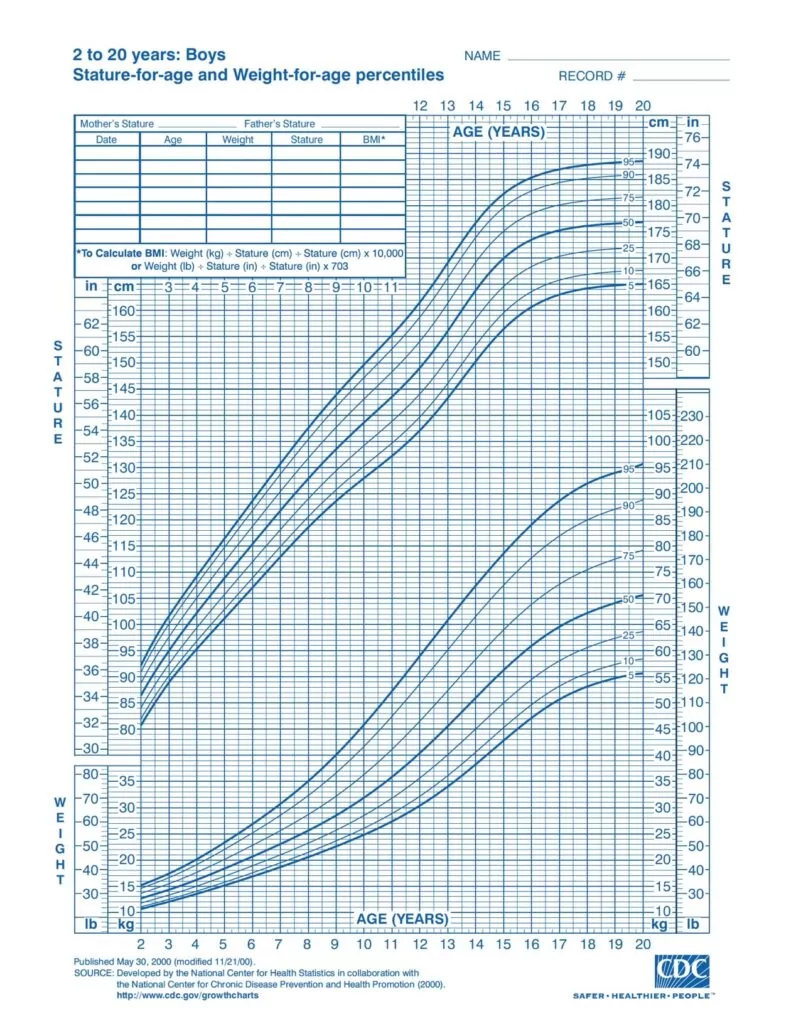When left untreated, children with CPP typically experience an initial early growth spurt but end up as shorter adults. However, treating CPP can help them achieve their predicted adult height (based on the height of their parents). As their parent or caregiver, you can use these downloadable growth charts from the MAGIC Foundation to keep an eye on your little one and see how they progress throughout treatment.
What are Growth Charts?

Growth charts, organized by age on the horizontal axis and various measurements on the vertical axis, are a visual representation of a child’s physical development over time. The key metrics commonly included are height (or length for infants), weight, and occasionally head circumference in the early years.
You may already be familiar with growth charts because doctors and other medical professionals use them to track your kid’s growth and development as a regular part of any child’s check-up, comparing their measurements to other children of the same age. These charts can provide an early warning about potential growth problems or other medical conditions and check if their growth is on the right track. Pretty cool, right?
Growth charts are not diagnostic instruments–they are a tool that contributes partly to a clinical impression and, potentially, a diagnosis. Your child’s doctor can determine if there is a medical problem or if your child’s growth is just something that needs to be watched.
How to Measure Your Child at Home
As your child undergoes treatment for their CPP, you can track their progress by measuring them at home. The MAGIC Foundation provides these instructions on how to measure your child correctly.
Before measuring, remove shoes, socks, and items like hair accessories or jackets. Go to a room with a hard floor (not carpeted) and have them stand against the wall. Their feet should be flat on the floor with their heels touching the wall. Their arms should be by their sides, and their head should face straight forward, not tilted up or down.
Using a hardcover book and a pencil, place the book on their head and make sure the side of the book is flat against the wall. Mark the spot where your child’s head meets the book. Have them step away and use a measuring tape to measure the exact difference from the mark to the floor. Record the number on a piece of paper.
You can use a flexible measuring tape or a piece of string to measure a child’s head. Wrap the string around the widest part of their head, hold it to a measuring tape, and record the number.
The MAGIC Foundation recommends repeating this process to confirm you have measured your child correctly. Once you have an accurate height measurement, you can use their downloadable growth chart for boys or growth chart for girls to compare your child’s height.


Stages of growth
Boys and girls exhibit distinct growth patterns from infancy to adolescence. These differences are influenced by genetics, hormones, and various environmental factors.
Infancy (0-2 years): Boys and girls typically experience rapid growth during the first few months of life. Girls tend to have a slightly lower birth weight and may exhibit a more gradual growth rate compared to boys.
Early Childhood (2-6 years): Both boys and girls continue to grow at a steady pace, with girls often showing a growth spurt earlier than boys.
Middle Childhood (6-10 years): Girls continue growing at a relatively steady pace, while boys may experience a growth spurt during this period. Individual variations become more apparent, and genetics play a significant role in determining height and other physical attributes.
Adolescence (10-18 years): Puberty marks a significant phase in growth in girls and boys. Girls typically experience their growth spurt earlier than boys, who undergo a later growth spurt, characterized by a rapid increase in height, muscle mass, and bone density.
Don’t panic if your kid’s measurements are a little smaller or larger than the average size on the growth chart. There is a wide range of typical measurements, and every kid is a little different. So just keep an eye on them and bring up any concerns at your next doctor’s appointment.
Growth and CPP
How does growth relate to CPP? When CPP is left untreated, it can cause premature growth plate fusion so that children stop growing too soon and are unlikely to reach their predicted adult height.
For example, most boys with CPP will not grow taller than five feet two inches, and girls often do not grow taller than five feet, as opposed to the national height averages of five feet nine inches for males and five feet three and a half inches for females. However, after starting CPP treatment, most children slow their velocity of bone maturation to a healthy, sustainable pace.
What is the MAGIC Foundation?
The MAGIC Foundation is an Illinois-based non-profit charity that provides support and services for families of children affected by a wide range of disorders, syndromes, and diseases that affect a child’s growth. Parents created this organization to reduce the trauma caused by growth disorders, leading to healthier, happier children (and adults!). Among the tools they provide are growth charts.
–
Using growth charts, you can track your kid’s development as they undergo CPP treatment. Growth charts are just one more tool you can use to monitor your child’s health and ensure that they’re on track to have a happy, healthy life.
TPI.2022.3354.v2 (v2.2)




